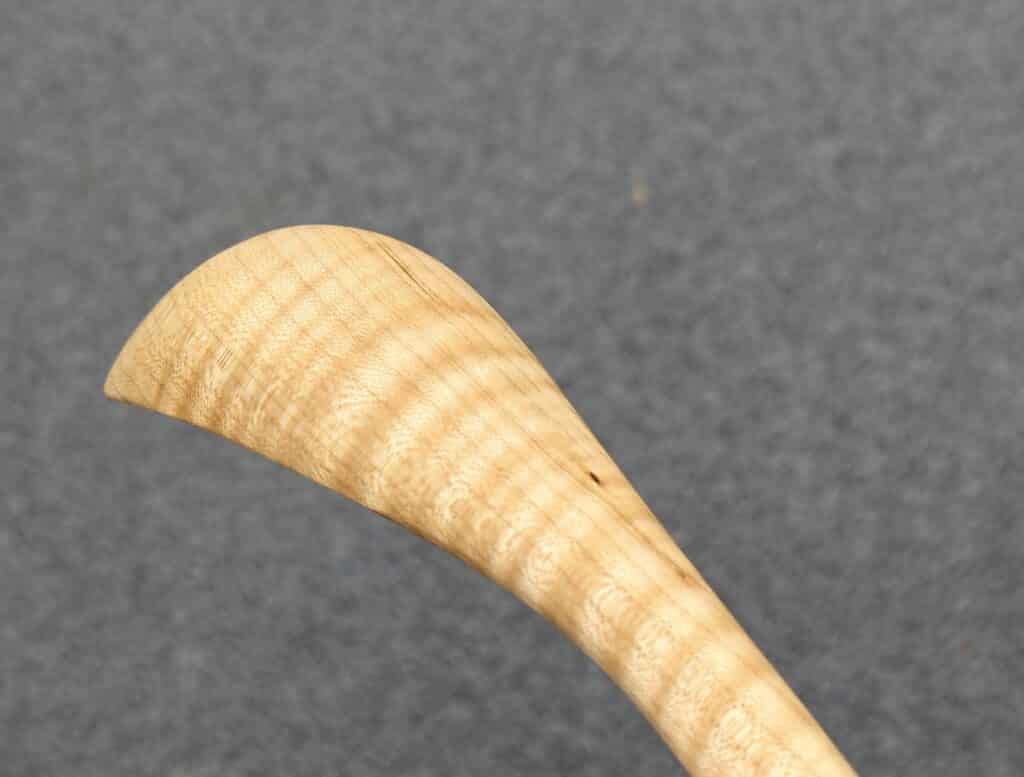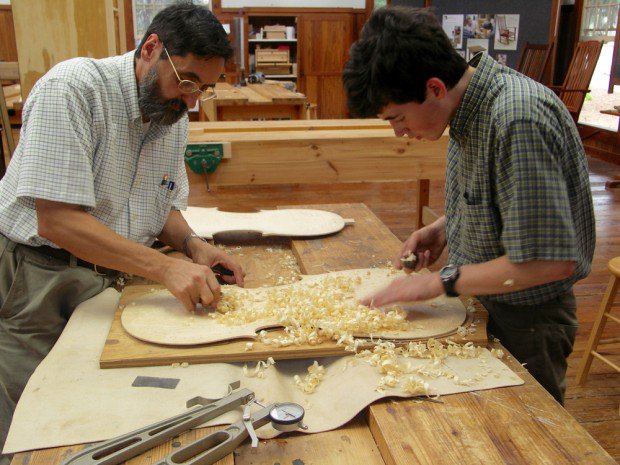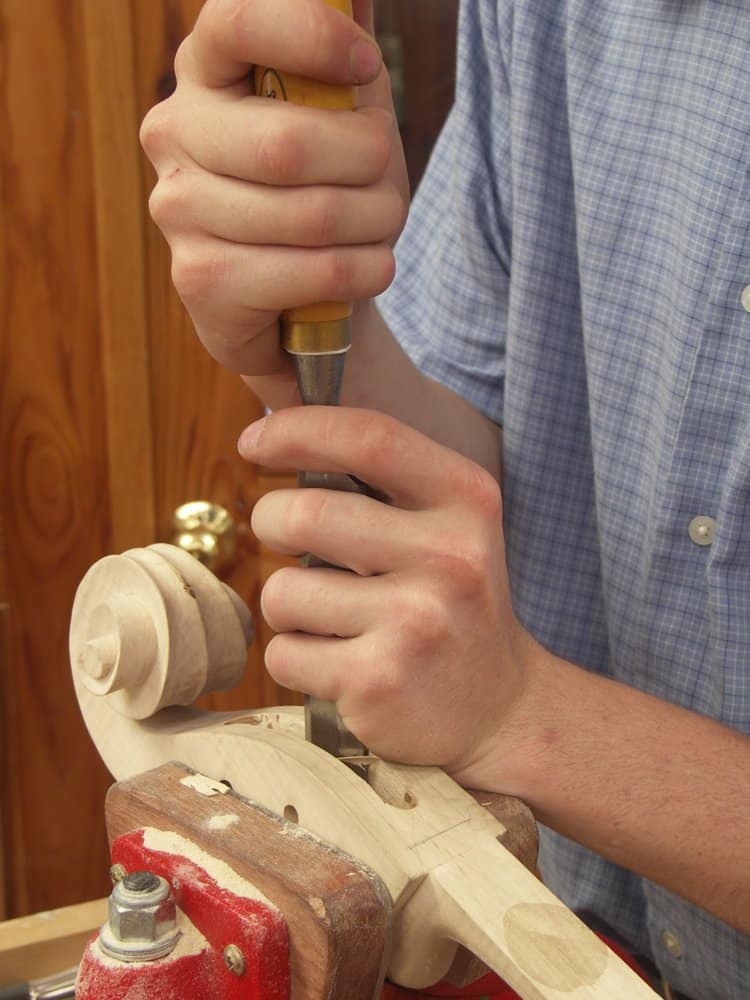Choosing a Wood
How often we see figured grain and say how pretty that looks (and it does), imagine exposing such beauty and such wood to enhance a piece like the neck of a spoon, a ladle’s bowl. Why choose so for the back of a cello and a violin, its neck and scroll and more in the bouts with tight curves bent so?

My three serving ladles came out well. The video filming will result in a video presentation for woodworking masterclasses in the near future. Scalloped with a gouge is the best way in so dense a hard-grained hardwood as no other tool really works too well when the wood is hard and no longer green no matter how sharp the edge.

I might take an hour to scallop such a hollow but mine this week took me twenty minutes to go from flat unworked wood to its final depth and smoothness. It worked well enough with my two freshly sharpened gouges and I’ve made three with no need of more sharpening. The two gouges I used are a 38mm #7 and a 25mm #8. without a second gouge go less deep or more deep and wider. I used a panel saw initially to rough down the bulk of waste wood and that was straightforward. The shaping of the outside came from a spokeshave and a rasp and for further refining, I relied on a card scraper shaped to smooth out the scallop.

But it’s the wood that’s important to consider. The curly grain was not picked for its pretty grain but for the grain’s inner structure. Curly woods like the maple and sycamore I used have an intrinsic strength rarely acknowledged or even considered as being critical to the work in hand. I feel this immeasurable inherent strength to be many times stronger for handles and the backs of bowed instruments. The undulating interlocking grain defies breakage when shaped components shift this way and that to suit the tasks intended to be expected of the wood used. On violins, violas and a cellos. the thinness can be 2.6 to 3mm thick and this thickness varies in every instrument made.

It’s the scallops that cause short grain as they are carved from the solid and not bent as some think. So too the walls or bouts of the violin. These curved parts measure as little as 1.5mm in thickness and its curly-grained or figured wood that creates the wholly essential walls of resistance under the great stresses under the straining that comes from the four taut strings and the playing of the instruments. The neck too is under tremendous stress. With all of this in mind, I felt the neck and bowl of the ladles needed similar consideration.

So I say all of this for everyone to reconsider why such woods might be picked for different tasks. in projects like the ladles, when the bowl is so deep, it’s important to have wood that’s equal to the task if indeed it is a lifetime utensil used in cooking and serving.

And finally. We must choose non-toxic woods as well as woods that will not flavour the food even though most woods will lose their flavour after a while. Do your research if you stray away from maple and sycamore. Also, some woods can be made into cooking utensils but remember plunging them into hot liquids can have an ongoing effect on the wood. Open-grained woods like oak, woods with large, open pores, etc, are not really suitable. Oak to will usually separate along the large medullary rays which open up and remain as thin cracks.


A beautiful ladle Paul, I was just thinking about making similar. I have a black plastic ladle, and I was reading something about plastic leaching the other week, which disturbed me slightly(!), and how black is the worst offender in the plastic world. I have no idea if it was true, and I can’t find the article again to fact check the science (or “science”).
Anyway, I decided to look into making a ladle and some other utensils, and I got stuck (procrastinated!) on the type of wood to use. The problem I have, is that I don’t have any wood lying around, as most of it is oak, and nor do I have any other projects in any other woods that I can use offcuts from. I’d feel a bit strange buying wood just to make utensils, although I’m not quite sure why! They just feel like things that are either made from offcuts, or cut directly off the tree. I’ve got a couple of trees in and around the garden, but nothing quite large enough to take prunings from, and I’m not altogether sure if the garden variety maple and rowan would ever produce anything of note anyway. Otherwise, I don’t have the confidence in my wood identifying skills to use something from my in-laws firewood pile. One of the reasons for making my own utensils would be to cut out the middle man supply chain of the modern world, with all its inherent issues, which sort of rules out buying from a timber supplier (there are none near me) or from ebay or wherever. Maybe I just need to build a sycamore desk or something!
Thanks again for another inspiring project,
Rico!
Nice article paul. I’m between to works, making my first el. guitar with flamed european maple carved top, and 1.5 mm thick same material finger binding for the fingerboard and a dovetail box (made out of sweet chestnut and some ebony).
Really interesting (and a bit tricky to work) material. Constantly sharping blades and card scrapers are really your frend.
Just about any hardwood is ok Rico, certainly maple or rowan. For these things working with green wood is much easier and -at least to me- more satisfying. Having said that you would want to do the finishing cuts once the wood has dried, a few days after roughing out the utensil. For things like a ladle the ideal is to use a natural crank, otherwise you can run into too much short grain
Thanks Jorge,
Can I ask, what do you mean by “natural crank”? It’s not a phrase I’m familiar with. It’ll probably be a couple of years until the maple tree has a thick enough branch for a ladle, and the rowan doesn’t look like it’ll ever get there! In the meantime, I’ll probably just keep looking around where I am to see if I can find anything. It’s mostly modern farmland around me, which is shorn of any trees (and general beauty!). I’m sure I’l find something!
Rico.
I think possibly he means natural crook, where a branch or a base of a tree trunk turns to absorb the components and the grain runs continuously around the bend.
Sorry, yes, as Paul says, a crook, or bend or curve. It could be a naturally bent branch, or where the branch meets the trunk or a bigger branch. Good luck with that, it is a lot of fun. Most of my kitchen utensils I have made, once you get used to wooden spoons you are not so keen of metal ones any more. My son has used his cherry breakfast spoon every day for a few years now. It is silky smooth now. My daughter lost her beloved beech one to the dog. I had sweet chestnut at hand so that’s what I used to replace it, open pores and that, but so far it is performing very well after less than a year.
Thanks Jorge (and Paul), much appreciated. I understand now, that makes complete sense. I have two or three wooden spoons that I’ve made, and I love the feel of them. I never thought about making one for my daughter’s breakfast, so I’ll do that, as I’m certain I can get something of appropriate size, even from the spindly trees in my garden! I did make her a tiny spoon for her play kitchen when she was little, and it has held up nicely. Time to make a proper one.
Interesting article. Thanks. I got into your style of woodworking via green woodworking and that via gathering and cutting firewood (much seemed too good to burn). So anyway I have carved several spoons, ladles, spatulas, a scoop and such, but all from green wood using a Swedish spoon knife and straight carving knife and a carving axe. Occasionally an adze too (not really needed for spoons, but recommended for greenwood bowls 😉 ). So very interested to read how you would do it and using dried wood rather than green. Thank you! 🙂
Hello Mr. Sellers, I wish to ask for some information on gauges. Is the brand Stubai good and are the sizes, especially the curvature numbers standard or do not correspond between brands? By the way, the ladle is very nice especially the curvature you have given it. Thanks very much for all the posts and videos you make.
Yes, Stubai is a good maker with standard sweeps as are Pfeil and one or two other makers.
Dear paul,
On your “making a chair devil” video, you filed a radius with a bevel into a scraper to make the blade. Is there a good angle for this bevel to roughly be?
Also, I think I didn’t understand properly how you sharpened the chair devil. Do you sharpen it like a scraper (ie burnish it and make a burr on it)? Or do chair devils not need the burr? Thankyou!
Warm rgds
Good questions, Paul. Any angle really but off a 90º by say 5–10º will give a good strength/resistance factor to stand against the force of wear. I never tried one against another because, of course, the bevel is trailing (on the back like a bevel-down iron) rather than moving into the wood. The filed edge is the cutting edge so, no, it’s not a turned edge as with a scraper. Refiling refreshes the cutting edge and you don’t need hardened steel just a fileable one.
Thankyou very much, very helpful, much appreciated, paul g